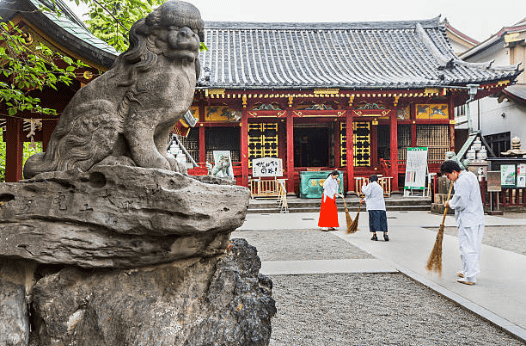Asakusa Jinja Shrine: A Hidden Gem in Tokyo
Asakusa Jinja Shrine, often referred to simply as Asakusa Shrine, is a Shinto shrine located very close to the famous Sensoji Temple in Asakusa, Tokyo. Although smaller than its grand neighbor Sensoji, this shrine offers a serene and peaceful atmosphere, a stark contrast to the usual bustling crowds at Sensoji. The shrine is also recognized nationally as an Important Cultural Property due to its long history and significance.
History of Asakusa Jinja

Origins and Foundation
Asakusa Jinja was founded in 1649 by Tokugawa Iemitsu, one of the shoguns of the Edo period. The shrine was established to honor the three individuals credited with founding and developing Sensoji Temple. According to legend, on May 17, 628, two fisherman brothers, Hinokuma Hamanari and Hinokuma Takenari, discovered a statue of Kannon Bosatsu caught in their nets in the Sumida River.
A wealthy landowner named Haji no Nakatomo heard of the discovery and approached the brothers to preach about Buddhism. Impressed by his sermon, the brothers embraced Buddhism.
The shrine was established to worship these three individuals as deities and to house the Kannon statue. Over time, it became an important center for both Shinto and Buddhist worship.
Connection to Sensoji
Interestingly, the history of Asakusa Jinja is closely linked with Sensoji Temple. The physical proximity of the Shinto shrine and the Buddhist temple reflects the close relationship between the two religions in Japan, where beliefs often coexist rather than exclude each other. Before the Meiji Restoration in 1868, many temples in Japan combined elements of Shinto and Buddhism in their rituals and architecture.
Surviving Disasters
One reason Asakusa Jinja is recognized as an Important Cultural Property is its survival through a series of disasters, including the Tokyo air raids of 1945, which destroyed many other buildings. The shrine, along with the nearby Nitenmon Gate, remains intact as a silent witness to Tokyo’s long history.
Architecture and Structure of Asakusa Jinja Shrine

Gongen-zukuri Style
Asakusa Jinja is built in the gongen-zukuri architectural style, characteristic of many Shinto shrines in Japan. This style features prominent roofs and intricate decorations. The main building of the shrine is adorned with beautiful carvings and details reflecting traditional Japanese art.
Key Components
Within the shrine complex, there are several important buildings besides the main shrine, including the kagura-den (kagura dance hall) and Hikan Inari Shrine. There is also a memorial stone for the renowned writer Kawaguchi Matsutaro, known for his historical and romantic novels adapted into films and TV shows.
Komainu
At the entrance of the shrine, you’ll be greeted by a pair of komainu statues, or lion-dogs, which guard the path to the shrine and ward off evil spirits. Uniquely, Asakusa Jinja also features two additional komainu statues known as Meoto Komainu, or “Married Lion-Dogs.” These statues are often visited by couples praying for a happy marriage and success in love.
Festivals and Events at Asakusa Jinja

Sanja Matsuri
One of Japan’s most famous festivals held at Asakusa Jinja is the Sanja Matsuri, taking place at the end of May each year. This festival is one of the largest in Tokyo, attracting hundreds of thousands of visitors who come to witness the mikoshi (portable shrine) parade and various cultural performances. Sanja Matsuri celebrates the founders of the shrine and is a time when the community gathers to celebrate their cultural heritage.
Traditional Activities
In addition to major festivals, Asakusa Jinja hosts various traditional activities throughout the year. Visitors can purchase ema (wooden plaques) and write their prayers and wishes before hanging them at the shrine. This activity allows people to leave their hopes and dreams to be protected by the shrine’s deities.
Location and Access
Asakusa Jinja is located on the eastern side of the Sensoji Temple complex. The shrine is open to the public and free to visit at any time. Its strategic location makes it easy for tourists to visit along with Sensoji Temple and other attractions in Asakusa.
How to Get to Asakusa Jinja
Asakusa Jinja is easily accessible within an 8-minute walk from several major Tokyo train stations:
- Asakusa Station (Tobu, Toei, and Tokyo Metro lines): 8 minutes on foot
- TX Asakusa Station (Tsukuba Express line): 8 minutes on foot
Personal Experience at Asakusa Jinja
Visiting Asakusa Jinja provides a peaceful escape from the hustle and bustle of Sensoji Temple. The shrine offers a chance to reflect and appreciate traditional Japanese architecture. Personally, I enjoyed the tranquil atmosphere, which made me feel closer to Japan’s history and culture.
One of my favorite moments was seeing the Meoto Komainu statues under their small umbrella. These statues are not only beautiful but are also said to be full of meaning, especially for those seeking blessings in marriage and love.
A visit to Asakusa Jinja also provides an opportunity to learn more about the unique relationship between Shinto and Buddhism in Japan. The coexistence of these two religions for centuries has created a rich and complex cultural heritage.
Exploring Asakusa? Be Sure to Visit This Shrine!
Asakusa Jinja is a hidden gem amidst the bustling streets of Asakusa. With its rich history, beautiful architecture, and peaceful ambiance, this shrine is a must-visit for anyone wanting to gain a deeper understanding of Japanese culture and history.
Whether you’re a traveler seeking new experiences or a local in need of reflection, Asakusa Jinja offers something special for everyone. So, when you’re in Tokyo, make sure to take the time to visit Asakusa Jinja and experience its magic for yourself.

Your point of view caught my eye and was very interesting. Thanks. I have a question for you.